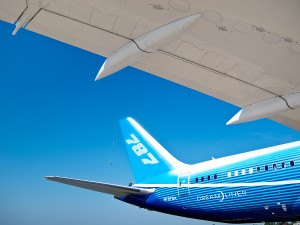

Canada’s transportation regulator ordered emergency-beacon inspections on most Boeing Co. and Airbus SAS jets after a Honeywell International Inc. device made in the country was linked to a 787 Dreamliner fire.
Airlines must complete the checks within 150 days of the airworthiness directive taking effect Aug. 26, Transport Canada said yesterday. Other nations typically follow such mandates and European and Japanese regulators today adopted the guidance.
Transport Canada’s order focuses on the possibility that a wiring fault on an emergency locator transmitter sparked a July 12 fire on a parked Boeing 787 in London. U.K. officials linked the unit to the blaze, and investigators are trying to learn whether two smashed-together wires may have caused a short circuit, a person familiar with the probe said last month.
The order is a prudent step to ensure safety while the investigation continues into the cause of the July fire, said Thomas Anthony, director of the University of Southern California’s Aviation Safety and Security Program. “If there’s a question as to whether or not a hazard exists then they generally will act in favor of a greater degree of safety.”
 The Canadian directive covers 11 Boeing-made models including the 787, 777 and 737 and seven from Airbus such as the A320, A330 and A380. The checks also were mandated for Dassault Aviation SA’s Falcon 7X business jet and Lockheed Martin Corp.’s L-382, a civilian model of the Hercules transport.
The Canadian directive covers 11 Boeing-made models including the 787, 777 and 737 and seven from Airbus such as the A320, A330 and A380. The checks also were mandated for Dassault Aviation SA’s Falcon 7X business jet and Lockheed Martin Corp.’s L-382, a civilian model of the Hercules transport.
The order applies worldwide, said Kelly James, a spokeswoman for Transport Canada. More than 3,000 aircraft are affected by the directive, said Philip Tang, the agency’s acting chief for continuing airworthiness.
Other countries grounded the 787 in January after the Federal Aviation Administration halted flights on the planes in the U.S. following two incidents in which lithium-ion batteries overheated on the aircraft. The FAA didn’t respond immediately to an e-mailed request for comment.
Airlines that have already done the beacon inspections don’t have to do them again. Boeing had recommended the checks last month.
ANA Holdings Inc. and United Airlines found damaged wires in beacons on some Dreamliners after checks last month following Boeing’s recommendation. Boeing supports making the inspections mandatory, Doug Alder, a spokesman for the Chicago-based company, said in an e-mailed statement yesterday.
Japan’s transport ministry also issued directives to the country’s airlines to inspect Honeywell beacons, according to a statement posted on the ministry’s Website. Japan’s directive covers 82 Boeing and Airbus planes, including 787s operated by Japan Air and ANA, according to the statement.
The European Aviation Safety Agency today likewise adopted Transport Canada’s order, extending the inspection mandate to all European carriers.
Honeywell supports the Canadian order and continues to cooperate with the agencies investigating the July 12 fire on an Ethiopian Airlines Enterprise plane, said Steve Brecken, a spokesman for the Morris Township, New Jersey-based company.
The 787 fire linked to the emergency beacons, which are powered by lithium batteries, renewed safety concerns regarding the Dreamliner’s electrical system. The plane was grounded for three months after the two January incidents with lithium-ion batteries. Boeing devised a fix that included more insulation around power cells and a metal enclosure.
As part of the investigation of the emergency transmitter, Canadian regulators inspected a Honeywell facility at Mississauga, Ontario, and an Instrumar Ltd. plant in St. John’s, Newfoundland. Instrumar is a subcontractor that manufactures the emergency locator transmitter from Honeywell’s design.
In the order, regulators told aircraft operators not to follow Honeywell’s original maintenance instructions on the beacons before revisions were made to the manual. The order didn’t explain what was wrong with those instructions.
On Aug. 14, Tokyo-based ANA Holdings discovered wiring defects in the fire-suppression system on three Dreamliners. The fault, which would have triggered the wrong extinguisher in case of a fire on one of the engines, was fixed by replacing parts on two 787s, with the third to be repaired by the end of the day, the airline said.
(With assistance from Julie Johnsson in Chicago, Alan Levin in Washington and Robert Wall in London. Editors: John Lear, Ed Dufner, Chris Jasper.)